by Jack F.
Wilson
(click on photos to enlarge image)
ANOINTING SPOON REPLICAS IN SILVER AND SILVER GILT
FROM GREAT BRITAIN
- PART 2
My collection presently has spoons dating from 1885 to 1997,
with one hundred and thirty-five examples. Fifty-four
silversmiths are represented in the collection, although not all
of them actually made the spoons they have marked as theirs,
particularly from 1936 onwards.
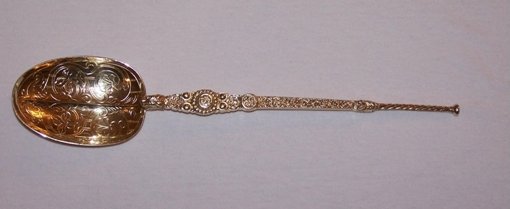 |
Spoon from the author's collection by Barker
Brothers Ltd, Birmingfham 1952, 25.30 cm
|
Examples of teaspoon-sized replicas with highly abbreviated
ornamentation began to appear in or around 1910. There were
vestigial remnants of some of the ornamentation on the original
spoon found on these examples, but many were definitely made
utilizing stamping machines and not cast. Earlier examples were
made up of cast [and sometimes stamped] parts sweated together.
Often the bowl engraving on the earlier examples was cast, but
many of these castings were refined by hand chasing. Bowl shape
varies as well. Some are rather narrow, others broad-ranging to
almost round. I have a few examples of a spade-shaped bowl. Also
around this time smaller versions to be used as salt and mustard
spoons began to appear.
In 1910 the pendant and brooch forms made their appearance.
Before the anticipated coronation of Edward VIII, and the
eventual coronation of George VI in 1937, several examples of
spoons were made for actual use, such as teaspoons, in addition
to being keepsakes or commemoratives.
Barry Potter made this observation: "The spoon design has
also been used in a variety of other silverware of which the
following have been observed or reported:
i) A brooch of 1 7/8" length, hallmarked Chester, made by C.D
Saunders & J.F.H. Shepherd.
ii) A necklace ornament of 1 1/2" length (in non-hallmarked
silver of non-British origin).
iii) A pair of sugar tongs (reported).
iv) A knife and fork set (reported).
v) A pickle fork of 6 5/8" length, hallmarked London 1910, and
made by Barnard & Sons.
vi) A Salt and Mustard Spoon Set, hallmarked Birmingham 1901,
but with the backs of each handle being plain.
vii) A pair of 20th Century Salt and Mustard Spoons,
incorporating the handle design only, the bowls being plain.
viii) A 2" high, ornamental chalice, hallmarked London 1910,
made by Saunders & Shepherd, with the spoon being used for the
handle. The side of the chalice has, in relief, the emblems of
England, Scotland and Ireland.
ix) A Toast Rack, hallmarked London 1910, made by Saunders &
Shepherd with pairs of 3" spoons [4 pairs], handles crossed,
used as the upright dividers. The central divider has two 4 1/2"
spoons, further embellished with the outline of a crown, as an
extension to the handles.
x) A set of 6 Coffee Spoons with a pair of Sugar Tongs [Cased]
of Dutch origin.
xi) A pair of pickle forks of 6 5/8" length, hallmarked London
1937 and made by Goldsmiths & Silversmiths Co., Ltd.
xii) A set of 6 Coffee Spoons of 4 1/8" length with a pair of
Sugar Tongs (Boxed), hallmarked London 1910, and made by
Saunders & Shepherd, stamped with a Registration Number of
57028.
Spoons have also been used in conjunction with other objects to
create presentation sets; one example of this is a cased set
containing an enamelled 8" spoon (Birmingham 1933), maker Levi &
Salaman] paired with a silver bowl (Chester 1910) making a
presentation Christening Set."
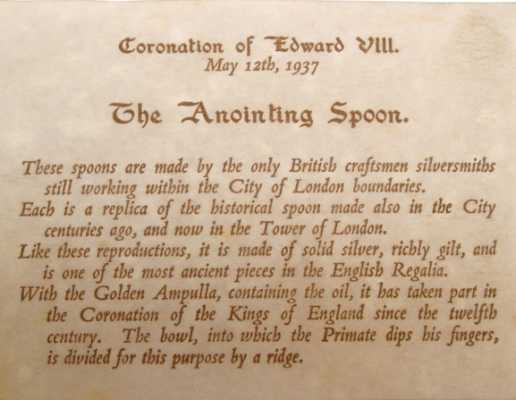 |
Parchment printed exposition of the Anointing
Spoon history
Photo courtesy Saunders Sheperd & Co Ltd.
|
It is obvious that a great many of the smaller late spoon forms
were made by stamping them out from one or two dies that were
utilized by a single (or a small number of) producer(s), and
then sold to other shops where their hallmarks and maker marks
were added. The uniformity of detail cannot admit any other
explanation. I have found only one example of the old quality
made after the 1953 coronation of Elizabeth II (1955, Saunders &
Shepherd).
From the earliest dates these spoons could be had in silver gilt
or in plain sterling silver. My 1885 example retains quite a bit
of its original gilding, and many examples of later date gleam
like solid gold.
When I wrote Mr. David Freeman-Valle, General Manager of
Saunders Shepherd & Co Ltd. of London [formerly, Saunders &
Shepherd], he made contact with several people in the firm and
asked them about any history of spoon production. Unfortunately,
the company’s records were destroyed in 1941 during the Blitz.
However, the present chairman, Mr. Tony Shepherd, had these
recollections:
"I can only state the fairly obvious, from memory, as you
know our records were destroyed by bombing in 1941. I recall:
- Associated with each Coronation.
- Always sterling silver.
- Usually the spline and bowl were cast as one but for the
larger spoons the splines and bowls were cast separately.
- The method of casting before 1941 was by "sand casting",
whereby a form was created by pressing the master-model into wet
sand, either in once piece or two pieces, later to be "sweated"
(fused) together. As can be imagined, this method gave rise to
many failures and faults unless the highest skills were employed,
until centrifugal casting was developed after (World War II).
Hence, SS&Co’s success in this field.
- The bowl was always gilded inside, if it had been cast as
opposed to pressed. Often the splines were gilded too."
Mr. Freeman-Valle also provided some excellent photographs from
the firm’s museum and from the personal collection of Mr. John
Coupland, Managing Director of SS&Co. Some of these photographs
appear in this article.
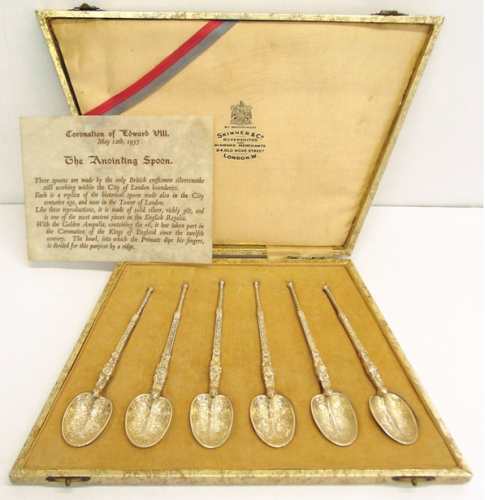 |
Cased set of spoons made to commemorate the
Coronation of Edward VIII,
which did not take place due to his abdication .
Photo courtesy Saunders Sheperd & Co Ltd.
|
Mr. James Deakin, of Deakin & Francis, Limited (formerly James
Deakin & Sons, Birmingham and Sheffield) responded to my request
for information thusly: "We undoubtedly made anointing spoons
but really do not have any records of them. This example (see
Addendum) from our museum was made for Edward VIII when he was
marrying Mrs. Simpson, but he abdicated before it happened!"
Craig Robathan, Proprietor of C. Robathan &Sons Ltd, a
Birmingham firm founded in 1908, passed on some information. "My
company made a tea spoon of 4 1/8” (10.50 cm) long, a salt spoon
of 2 3/8” (6.0 cm) long and a mustard spoon of 2 5/8” (6.70 cm)
long. We started making the Anointing Spoons in 1952 in time for
the Queen’s Coronation in 1953." The latest spoon from this firm
in my collection dates to 1997.
So many of the silversmiths were in business for such a short
time, and their records are just non-existent, being lost or
destroyed. Many of the firms only issued one spoon, because they
were in production for only one year, their owners moving in and
out of business as shop masters, partners and journeymen. But
the great firms, Saunders & Shepherd, Wakeley & Wheeler (taken
over by Barry Witmond, who did his apprenticeship there), The
Goldsmiths & Silversmiths Company [acquired by Garrard],
produced top quality replicas over the years with high
consistency. It is to be hoped that, should Queen Elizabeth II
live another five years, these firms will continue their
tradition and offer replicas to celebrate her Diamond Jubilee.
And if she turns out to live as long as The Queen Mother did, we
might look forward to spoons commemorating the longest reign in
British history. At any rate, collectors would be gratified to
be treated to fine quality replicas in the future and not have
to be satisfied with the stamped, souvenir-type spoons so common
today.
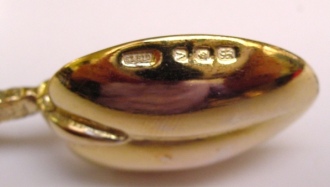 |
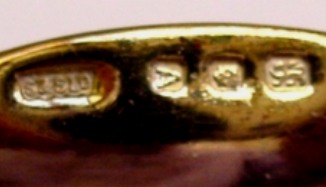 |
Back of bowl with Saunders & Co maker's mark
Photo courtesy Saunders Sheperd & Co Ltd.
|
Detail of Saunders & Co maker's mark
Photo courtesy Saunders Sheperd & Co Ltd.
|
Collecting these spoons presents its own problems. Most shop
owners and other vendors do not know what they have. They know
they have a British spoon, maybe even the assay city and the
year mark. Rarely do they know the maker. They don’t know what
kind of spoon it is, nor really how to price it, since no
catalogues or guides exist. eBay usually has several examples
for auction at any given time. The lack of knowledge found in
established shops is equally present on eBay. Uniformity of
valuing is similarly lacking. A spoon worth seventy-five to one
hundred dollars may languish for weeks on end with a
four-hundred and fifty dollar starting price, while a quite
valuable and rare spoon may be offered with no reserve and a
starting price of ninety-nine cents. It is very much of a flea
market atmosphere. Having said this, I must assert that eBay has
been a wonderful venue for collecting these spoons, and the
sellers have been uniformly kind and helpful.
The collecting of these Anointing Spoon replicas has brought me
considerable joy in the hunt and the acquisition; kindled my
enthusiasm for detective work in trying to puzzle out the
identities of silversmiths; and many hours of relaxation
studying the intricacies of design and execution of these spoons.
It has also given me a glimpse into the continuity of tradition
in the life of the British people and the heritage of their
great workshops of guildsmen.
Acknowledgements: Thanks go to my friend, mentor, and fellow
collector, Barry Potter of Hayes, Middlesex, England, who
provided invaluable and hard-sought material for this article.
As a body of information, it is not found anywhere else, and I
could not have found all of his sources on my own. His
generosity in sharing this information is deeply gratifying. Mr.
David Freeman-Valle, General Manager of Saunders Shepherd & Co
Ltd., was most generous in his time and efforts in tracking down
members of the firm who might have the information I requested
and in providing and making some of the photographs. Mr. Tony
Shepherd, Chairman of SS&Co, provided invaluable memories of
spoon production. Mr. John Coupland, Managing Director of SS&Co,
generously shared part of his private collection to be
photographed. SS&Co provided photographs of spoons from their
museum. Mr. James Deakin of Deakin & Francis, Ltd provided an
anecdote and some photographs. I exchanged several emails with
Craig Robathan, Proprietor of C. Robathan & Sons Ltd,
Birmingham. He very kindly looked into their reco (If you have a
request of them, please provide a photograph or drawing of the
maker’s mark). Thanks are due to those representatives of firms
and organizations who responded to my requests for information
with sincere regrets. So much valuable information has been
destroyed or lost.
|
Jack F. Wilson - 2008 -
JACK FOWLER WILSON is a retired Episcopal priest
living in the southeastern United States in Alabama. His
enthusiasm for collecting these spoons comes from an
appreciation of fine craftsmanship and British ancestry
on both sides of his family.
His father’s parents emigrated from England, and his
mother’s family came to these shores from Scotland and
Wales.
Owing to his heavy health problems Jack F. Wilson is resolved to sell his wide collection of silver anointing spoons.
People interested to his unique collection may contact Rev. Wilson at
presterjack1@aol.com
|
|
|
 ASSOCIATION OF SMALL COLLECTORS OF ANTIQUE SILVER
ASSOCIATION OF SMALL COLLECTORS OF ANTIQUE SILVER






